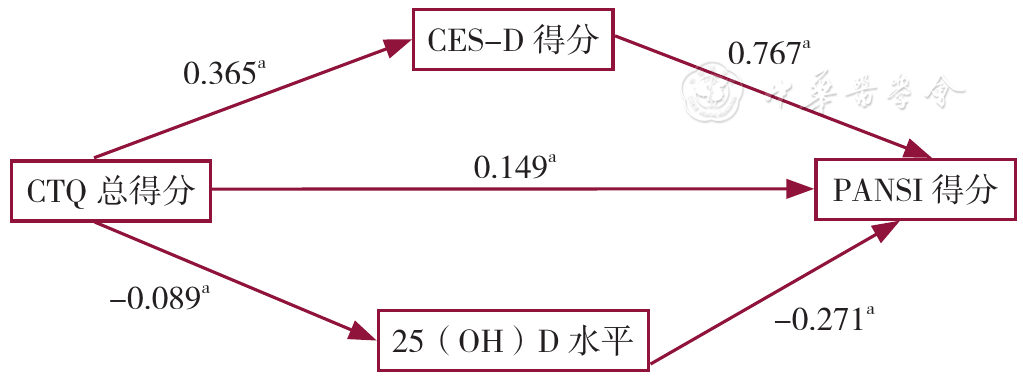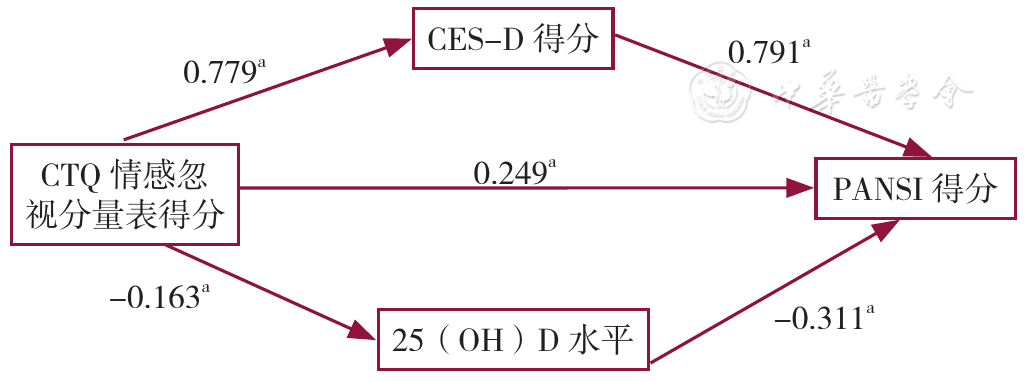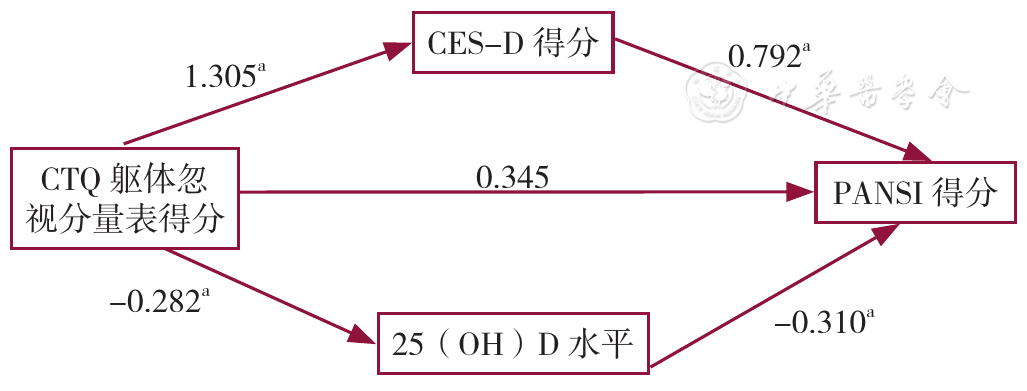中国全科医学 ›› 2025, Vol. 28 ›› Issue (13): 1614-1621.DOI: 10.12114/j.issn.1007-9572.2024.0298
所属专题: 儿科最新文章合辑; 心理健康最新文章合辑
赵丽丽1, 刘乐伟2, 耿峰3, 莫大明4, 刘寰忠2,*( )
)
收稿日期:2024-08-12
修回日期:2024-11-18
出版日期:2025-05-05
发布日期:2025-03-17
通讯作者:
刘寰忠
作者贡献:
赵丽丽负责研究设计、论文撰写与修改;刘乐伟负责研究设计、论文选题和修改;耿峰、莫大明负责研究实施、论文修改;刘寰忠负责研究设计、论文选题、论文修改、经费获取,对文章整体负责。
基金资助:
ZHAO Lili1, LIU Lewei2, GENG Feng3, MO Daming4, LIU Huanzhong2,*( )
)
Received:2024-08-12
Revised:2024-11-18
Published:2025-05-05
Online:2025-03-17
Contact:
LIU Huanzhong
摘要: 背景 童年创伤是抑郁障碍患者自杀意念的危险因素,血浆维生素D水平也与自杀意念相关,而目前在青少年抑郁障碍患者中关于其相互关系的探究尚不足。 目的 探讨自杀意念与童年创伤的关系,并分析抑郁症状严重程度和低维生素D水平的中介作用。 方法 以2021年在安徽医科大学附属巢湖医院和合肥市第四人民医院就诊的青少年抑郁障碍患者为抑郁障碍组(n=168),以同期招募的无精神疾病史青少年为对照组(n=89)。采用儿童期虐待问卷(CTQ)、流调抑郁量表(CES-D)、自杀意念量表(PANSI)评估童年创伤、抑郁症状、自杀意念,同时检测血浆25-羟维生素D[25(OH)D]水平。比较抑郁障碍组青少年和对照组青少年在自杀意念、抑郁症状、童年创伤及维生素D水平之间的差异;采用Pearson相关分析检验各量表得分的相关性,并通过PROCESS宏程序分析抑郁和维生素D水平在童年创伤与自杀意念之间的中介作用。 结果 抑郁障碍组的PANSI得分、CTQ各分量表得分及总得分高于对照组(P<0.05),25(OH)D水平低于对照组(P<0.05)。Pearson相关分析显示,抑郁障碍组的PANSI得分与CTQ总分、CES-D得分、25(OH)D水平存在相关性(P<0.05),对照组的PANSI得分与CTQ总得分、CES-D得分存在相关性(P<0.05);与25(OH)D水平无相关关系(P>0.05)。中介效应分析显示:抑郁障碍组的CES-D得分和25(OH)D水平在CTQ总得分和PANSI得分之间发挥部分中介作用,中介效应占比分别为61.8%和5.3%;在CTQ情感虐待分量表得分和PANSI得分之间发挥部分中介作用,中介效应占比分别为58.9%和6.5%;在CTQ情感忽视分量表得分和PANSI得分之间发挥部分中介作用,中介效应占比分别为67.2%和5.6%;在CTQ躯体忽视分量表得分和PANSI得分之间发挥完全中介作用,中介效应占比为92.2%和7.8%。对照组的25(OH)D水平中介效应均不显著;CES-D得分在CTQ总得分与PANSI得分之间、CTQ情感虐待分量表得分和PANSI得分之间发挥完全中介作用;在CTQ情感忽视分量表得分与PANSI得分之间发挥部分中介作用,直接效应占比为41.5%,中介效应占比为58.5%;在CTQ躯体忽视分量表得分和PANSI得分之间的中介效应不显著。 结论 青少年抑郁障碍患者的抑郁症状严重程度和低维生素D水平是童年创伤导致自杀意念的潜在机制。临床中针对合并童年创伤的青少年抑郁障碍患者应及时、有效地控制和改善病情,提高其维生素D水平,并积极开展心理健康教育,以减少自杀意念的发生,提高临床预后。
| 组别 | 人数 | 性别(男/女) | 年龄( | BMI( | CTQ得分( | CES-D得分( | PANSI得分( | 25(OH)D水平( | |||||
|---|---|---|---|---|---|---|---|---|---|---|---|---|---|
| 情感虐待 | 躯体虐待 | 性虐待 | 情感忽视 | 躯体忽视 | 总得分 | ||||||||
| 对照组 | 89 | 56/33 | 15.0±1.7 | 21.0±4.3 | 6.5±1.9 | 5.4±1.3 | 5.1±0.8 | 9.7±3.9 | 7.8±2.9 | 45.0±5.8 | 7.7±7.5 | 20.0±5.5 | 22.4±7.1 |
| 抑郁障碍组 | 168 | 46/122 | 15.4±1.6 | 21.0±4.2 | 11.7±4.5 | 7.3±3.0 | 5.9±2.3 | 15.9±5.1 | 10.7±3.3 | 51.4±12.8 | 37.7±12.0 | 48.6±12.7 | 15.0±4.7 |
| t(χ2)值 | 30.700a | -1.880 | 0.105 | -13.178 | -6.846 | -3.700 | -10.692 | -6.897 | -5.501 | -24.675 | -25.096 | 8.798 | |
| P值 | <0.001 | 0.061 | 0.916 | <0.001 | <0.001 | <0.001 | <0.001 | <0.001 | <0.001 | <0.001 | <0.001 | <0.001 | |
表1 抑郁障碍组和对照组青少年的临床资料比较
Table 1 Comparison of clinical data between adolescent patients with depressive disorder and control group
| 组别 | 人数 | 性别(男/女) | 年龄( | BMI( | CTQ得分( | CES-D得分( | PANSI得分( | 25(OH)D水平( | |||||
|---|---|---|---|---|---|---|---|---|---|---|---|---|---|
| 情感虐待 | 躯体虐待 | 性虐待 | 情感忽视 | 躯体忽视 | 总得分 | ||||||||
| 对照组 | 89 | 56/33 | 15.0±1.7 | 21.0±4.3 | 6.5±1.9 | 5.4±1.3 | 5.1±0.8 | 9.7±3.9 | 7.8±2.9 | 45.0±5.8 | 7.7±7.5 | 20.0±5.5 | 22.4±7.1 |
| 抑郁障碍组 | 168 | 46/122 | 15.4±1.6 | 21.0±4.2 | 11.7±4.5 | 7.3±3.0 | 5.9±2.3 | 15.9±5.1 | 10.7±3.3 | 51.4±12.8 | 37.7±12.0 | 48.6±12.7 | 15.0±4.7 |
| t(χ2)值 | 30.700a | -1.880 | 0.105 | -13.178 | -6.846 | -3.700 | -10.692 | -6.897 | -5.501 | -24.675 | -25.096 | 8.798 | |
| P值 | <0.001 | 0.061 | 0.916 | <0.001 | <0.001 | <0.001 | <0.001 | <0.001 | <0.001 | <0.001 | <0.001 | <0.001 | |
| 组别 | 人数 | CTQ得分(分) | CES-D得分(分) | PANSI得分(分) | 25(OH)D水平(μg/L) | |||||
|---|---|---|---|---|---|---|---|---|---|---|
| 情感虐待 | 躯体虐待 | 性虐待 | 情感忽视 | 躯体忽视 | 总得分 | |||||
| 对照组 | 89 | 6.6±0.4 | 5.5±0.3 | 5.2±0.2 | 9.9±0.5 | 7.8±0.4 | 45.4±1.2 | 8.5±1.2 | 21.2±1.2 | 21.8±0.6 |
| 抑郁障碍组 | 168 | 11.6±0.3 | 7.3±0.2 | 5.8±0.2 | 15.8±0.4 | 10.7±0.3 | 51.2±0.9 | 37.3±0.8 | 48.0±0.8 | 15.3±0.4 |
| t值 | -9.428 | -4.887 | -2.377 | -8.894 | -6.430 | -3.778 | -19.538 | -18.482 | 8.718 | |
| P值 | <0.001 | <0.001 | 0.018 | <0.001 | <0.001 | <0.001 | <0.001 | <0.001 | <0.001 | |
表2 调整协变量后抑郁障碍组和对照组青少年的临床资料比较(±s)
Table 2 Comparison of clinical data between adolescent patients with depressive disorder and control group after adjusting for covariates
| 组别 | 人数 | CTQ得分(分) | CES-D得分(分) | PANSI得分(分) | 25(OH)D水平(μg/L) | |||||
|---|---|---|---|---|---|---|---|---|---|---|
| 情感虐待 | 躯体虐待 | 性虐待 | 情感忽视 | 躯体忽视 | 总得分 | |||||
| 对照组 | 89 | 6.6±0.4 | 5.5±0.3 | 5.2±0.2 | 9.9±0.5 | 7.8±0.4 | 45.4±1.2 | 8.5±1.2 | 21.2±1.2 | 21.8±0.6 |
| 抑郁障碍组 | 168 | 11.6±0.3 | 7.3±0.2 | 5.8±0.2 | 15.8±0.4 | 10.7±0.3 | 51.2±0.9 | 37.3±0.8 | 48.0±0.8 | 15.3±0.4 |
| t值 | -9.428 | -4.887 | -2.377 | -8.894 | -6.430 | -3.778 | -19.538 | -18.482 | 8.718 | |
| P值 | <0.001 | <0.001 | 0.018 | <0.001 | <0.001 | <0.001 | <0.001 | <0.001 | <0.001 | |
| 变量 | 年龄 | 性别 | CTQ总得分 | CTQ情感虐待分量表得分 | CTQ躯体虐待分量表得分 | CTQ性虐待分量表得分 | CTQ情感忽视分量表得分 | CTQ躯体忽视分量表得分 | PANSI得分 | CES-D得分 | 25(OH)D水平 |
|---|---|---|---|---|---|---|---|---|---|---|---|
| 年龄 | 1.000 | — | — | — | — | — | — | — | — | — | — |
| 性别 | 0.192a | 1.000 | — | — | — | — | — | — | — | — | — |
| CTQ总得分 | -0.147 | -0.137 | 1.000 | — | — | — | — | — | — | — | — |
| CTQ情感虐待分量表得分 | -0.155a | -0.181a | 0.814a | 1.000 | — | — | — | — | — | — | — |
| CTQ躯体虐待分量表得分 | 0.059 | 0.053 | 0.581a | 0.433a | 1.000 | — | — | — | — | — | — |
| CTQ性虐待分量表得分 | -0.004 | -0.107 | 0.321a | 0.173a | 0.109 | 1.000 | — | — | — | — | — |
| CTQ情感忽视分量表得分 | -0.155a | -0.121 | 0.815a | 0.526a | 0.283a | 0.041 | 1.000 | — | — | — | — |
| CTQ躯体忽视分量表得分 | -0.169a | -0.071 | 0.744a | 0.463a | 0.231a | 0.147 | 0.600a | 1.000 | — | — | — |
| PANSI得分 | -0.269a | -0.311a | 0.458a | 0.379a | 0.207a | 0.152a | 0.372a | 0.387a | 1.000 | — | — |
| CES-D得分 | -0.227a | -0.255a | 0.390a | 0.300a | 0.141 | 0.128 | 0.334a | 0.364a | 0.802a | 1.000 | — |
| 25(OH)D水平 | 0.217a | 0.275a | -0.243a | -0.241a | -0.136 | -0.012 | -0.180a | -0.202a | -0.258a | -0.168a | 1.000 |
表3 抑郁障碍组青少年CTQ得分、CES-D得分、PANSI得分、25(OH)D水平的相关性分析(r值)
Table 3 Correlation analysis of CTQ scores,CES-D scores,PANSI scores and 25(OH)levels in adolescents with depressive disorders
| 变量 | 年龄 | 性别 | CTQ总得分 | CTQ情感虐待分量表得分 | CTQ躯体虐待分量表得分 | CTQ性虐待分量表得分 | CTQ情感忽视分量表得分 | CTQ躯体忽视分量表得分 | PANSI得分 | CES-D得分 | 25(OH)D水平 |
|---|---|---|---|---|---|---|---|---|---|---|---|
| 年龄 | 1.000 | — | — | — | — | — | — | — | — | — | — |
| 性别 | 0.192a | 1.000 | — | — | — | — | — | — | — | — | — |
| CTQ总得分 | -0.147 | -0.137 | 1.000 | — | — | — | — | — | — | — | — |
| CTQ情感虐待分量表得分 | -0.155a | -0.181a | 0.814a | 1.000 | — | — | — | — | — | — | — |
| CTQ躯体虐待分量表得分 | 0.059 | 0.053 | 0.581a | 0.433a | 1.000 | — | — | — | — | — | — |
| CTQ性虐待分量表得分 | -0.004 | -0.107 | 0.321a | 0.173a | 0.109 | 1.000 | — | — | — | — | — |
| CTQ情感忽视分量表得分 | -0.155a | -0.121 | 0.815a | 0.526a | 0.283a | 0.041 | 1.000 | — | — | — | — |
| CTQ躯体忽视分量表得分 | -0.169a | -0.071 | 0.744a | 0.463a | 0.231a | 0.147 | 0.600a | 1.000 | — | — | — |
| PANSI得分 | -0.269a | -0.311a | 0.458a | 0.379a | 0.207a | 0.152a | 0.372a | 0.387a | 1.000 | — | — |
| CES-D得分 | -0.227a | -0.255a | 0.390a | 0.300a | 0.141 | 0.128 | 0.334a | 0.364a | 0.802a | 1.000 | — |
| 25(OH)D水平 | 0.217a | 0.275a | -0.243a | -0.241a | -0.136 | -0.012 | -0.180a | -0.202a | -0.258a | -0.168a | 1.000 |
| 变量 | 年龄 | 性别 | CTQ总得分 | CTQ情感虐待分量表得分 | CTQ躯体虐待分量表得分 | CTQ性虐待分量表得分 | CTQ情感忽视分量表得分 | CTQ躯体忽视分量表得分 | PANSI得分 | CES-D得分 | 25(OH)D水平 |
|---|---|---|---|---|---|---|---|---|---|---|---|
| 年龄 | 1.000 | — | — | — | — | — | — | — | — | — | — |
| 性别 | -0.116 | 1.000 | — | — | — | — | — | — | — | — | — |
| CTQ总得分 | 0.194 | 0.003 | 1.000 | — | — | — | — | — | — | — | — |
| CTQ情感虐待分量表得分 | 0.112 | -0.034 | 0.583a | 1.000 | — | — | — | — | — | — | — |
| CTQ躯体虐待分量表得分 | -0.002 | -0.017 | 0.464a | 0.389a | 1.000 | — | — | — | — | — | — |
| CTQ性虐待分量表得分 | 0.091 | 0.088 | 0.404a | 0.615a | 0.112 | 1.000 | — | — | — | — | — |
| CTQ情感忽视分量表得分 | 0.088 | -0.030 | 0.622a | 0.012 | 0.172 | -0.055 | 1.000 | — | — | — | — |
| CTQ躯体忽视分量表得分 | 0.206 | 0.063 | 0.629a | 0.191 | -0.002 | 0.189 | 0.275a | 1.000 | — | — | — |
| PANSI得分 | 0.231a | -0.125 | 0.446a | 0.235a | 0.338a | -0.009 | 0.390a | 0.253a | 1.000 | — | — |
| CES-D得分 | 0.213a | -0.017 | 0.479a | 0.399a | 0.340a | 0.156 | 0.345a | 0.154 | 0.718a | 1.000 | — |
| 25(OH)D水平 | 0.266a | 0.273a | 0.192 | 0.069 | -0.136 | 0.001 | -0.219a | 0.160 | 0.092 | 0.089 | 1.000 |
表4 对照组青少年CTQ得分、CES-D得分、PANSI得分、25(OH)D水平的相关性分析(r值)
Table 4 Correlation analysis of CTQ scores,CES-D scores,PANSI scores and 25(OH)levels in control group
| 变量 | 年龄 | 性别 | CTQ总得分 | CTQ情感虐待分量表得分 | CTQ躯体虐待分量表得分 | CTQ性虐待分量表得分 | CTQ情感忽视分量表得分 | CTQ躯体忽视分量表得分 | PANSI得分 | CES-D得分 | 25(OH)D水平 |
|---|---|---|---|---|---|---|---|---|---|---|---|
| 年龄 | 1.000 | — | — | — | — | — | — | — | — | — | — |
| 性别 | -0.116 | 1.000 | — | — | — | — | — | — | — | — | — |
| CTQ总得分 | 0.194 | 0.003 | 1.000 | — | — | — | — | — | — | — | — |
| CTQ情感虐待分量表得分 | 0.112 | -0.034 | 0.583a | 1.000 | — | — | — | — | — | — | — |
| CTQ躯体虐待分量表得分 | -0.002 | -0.017 | 0.464a | 0.389a | 1.000 | — | — | — | — | — | — |
| CTQ性虐待分量表得分 | 0.091 | 0.088 | 0.404a | 0.615a | 0.112 | 1.000 | — | — | — | — | — |
| CTQ情感忽视分量表得分 | 0.088 | -0.030 | 0.622a | 0.012 | 0.172 | -0.055 | 1.000 | — | — | — | — |
| CTQ躯体忽视分量表得分 | 0.206 | 0.063 | 0.629a | 0.191 | -0.002 | 0.189 | 0.275a | 1.000 | — | — | — |
| PANSI得分 | 0.231a | -0.125 | 0.446a | 0.235a | 0.338a | -0.009 | 0.390a | 0.253a | 1.000 | — | — |
| CES-D得分 | 0.213a | -0.017 | 0.479a | 0.399a | 0.340a | 0.156 | 0.345a | 0.154 | 0.718a | 1.000 | — |
| 25(OH)D水平 | 0.266a | 0.273a | 0.192 | 0.069 | -0.136 | 0.001 | -0.219a | 0.160 | 0.092 | 0.089 | 1.000 |

图1 抑郁障碍组青少年CES-D得分和25(OH)D水平在CTQ总得分和PANSI得分关系中的中介效应分析注:CTQ=童年创伤量表,CES-D=流调用抑郁自评量表,PANSI=自杀意念量表,25(OH)D=25-羟维生素D;a表示P<0.05。
Figure 1 Mediating effects of CES-D scores and 25(OH)D level in the relationship between CTQ scores and PANSI scores in adolescent depressive disorder

图2 抑郁障碍组青少年CES-D得分和25(OH)D水平在CTQ情感虐待分量表得分和PANSI得分关系中的中介效应分析注:a表示P<0.05。
Figure 2 Mediating effects of CES-D scores and 25(OH)D level in the relationship between emotional abuse scores and PANSI scores in adolescent depressive disorder

图3 抑郁障碍组青少年CES-D得分和25(OH)D水平在CTQ情感忽视分量表得分和PANSI得分关系中的中介效应分析注:a表示P<0.05。
Figure 3 Mediating effects of CES-D scores and 25(OH)D level in the relationship between emotional neglect scores and PANSI scores in adolescent depressive disorder

图4 抑郁障碍组青少年CES-D得分和25(OH)D水平在CTQ躯体忽视分量表得分和PANSI得分关系中的中介效应分析注:a表示P<0.05。
Figure 4 Mediating effects of CES-D scores and 25(OH)D level in the relationship between physical neglect scores and PANSI scores in adolescent depressive disorder
| 模型 | 项目 | 效应值 | 95%CI | 标准误 | 效应占比(%) |
|---|---|---|---|---|---|
| 模型1 | 总效应 | 0.453 | 0.318~0.588 | 0.068 | — |
| 直接效应 | 0.149 | 0.054~0.245 | 0.049 | 32.9 | |
| 总间接效应 | 0.304 | 0.183~0.429 | 0.063 | 67.1 | |
| CTQ总得分→CES-D得分→PANSI得分 | 0.280 | 0.161~0.407 | 0.063 | 61.8 | |
| CTQ总得分→25(OH)D水平→PANSI得分 | 0.024 | 0.003~0.054 | 0.013 | 5.3 | |
| 模型2 | 总效应 | 1.077 | 0.674~1.480 | 0.204 | — |
| 直接效应 | 0.373 | 0.105~0.640 | 0.136 | 34.6 | |
| 总间接效应 | 0.704 | 0.363~1.059 | 0.175 | 65.4 | |
| CTQ情感虐待分量表得分→CES-D得分→PANSI得分 | 0.634 | 0.295~0.987 | 0.176 | 58.9 | |
| CTQ情感虐待分量表得分→25(OH)D水平→PANSI得分 | 0.070 | 0.008~0.151 | 0.038 | 6.5 | |
| 模型3 | 总效应 | 0.916 | 0.565~1.266 | 0.178 | — |
| 直接效应 | 0.249 | 0.014~0.483 | 0.119 | 27.2 | |
| 总间接效应 | 0.667 | 0.355~0.995 | 0.165 | 72.8 | |
| CTQ情感忽视分量表得分→CES-D得分→PANSI得分 | 0.616 | 0.306~0.941 | 0.161 | 67.2 | |
| CTQ情感忽视分量表得分→25(OH)D水平→PANSI得分 | 0.051 | 0.003~0.120 | 0.031 | 5.6 | |
| 模型4 | 总效应 | 1.466 | 0.931~2.002 | 0.271 | — |
| 直接效应 | 0.345 | -0.022~0.713 | 0.186 | — | |
| 总间接效应 | 1.121 | 0.711~1.583 | 0.223 | 100.0 | |
| CTQ躯体忽视分量表得分→CES-D得分→PANSI得分 | 1.034 | 0.629~1.496 | 0.219 | 92.2 | |
| CTQ躯体忽视分量表得分→25(OH)D水平→PANSI得分 | 0.087 | 0.012~0.203 | 0.049 | 7.8 |
表5 抑郁障碍组青少年CES-D得分和25(OH)D水平在CTQ得分和PANSI得分关系中的双中介效应检验
Table 5 Double mediating effects of CES-D scores and 25(OH)D levels in the relationship between CTQ scores and PANSI scores in adolescent depressive disorder
| 模型 | 项目 | 效应值 | 95%CI | 标准误 | 效应占比(%) |
|---|---|---|---|---|---|
| 模型1 | 总效应 | 0.453 | 0.318~0.588 | 0.068 | — |
| 直接效应 | 0.149 | 0.054~0.245 | 0.049 | 32.9 | |
| 总间接效应 | 0.304 | 0.183~0.429 | 0.063 | 67.1 | |
| CTQ总得分→CES-D得分→PANSI得分 | 0.280 | 0.161~0.407 | 0.063 | 61.8 | |
| CTQ总得分→25(OH)D水平→PANSI得分 | 0.024 | 0.003~0.054 | 0.013 | 5.3 | |
| 模型2 | 总效应 | 1.077 | 0.674~1.480 | 0.204 | — |
| 直接效应 | 0.373 | 0.105~0.640 | 0.136 | 34.6 | |
| 总间接效应 | 0.704 | 0.363~1.059 | 0.175 | 65.4 | |
| CTQ情感虐待分量表得分→CES-D得分→PANSI得分 | 0.634 | 0.295~0.987 | 0.176 | 58.9 | |
| CTQ情感虐待分量表得分→25(OH)D水平→PANSI得分 | 0.070 | 0.008~0.151 | 0.038 | 6.5 | |
| 模型3 | 总效应 | 0.916 | 0.565~1.266 | 0.178 | — |
| 直接效应 | 0.249 | 0.014~0.483 | 0.119 | 27.2 | |
| 总间接效应 | 0.667 | 0.355~0.995 | 0.165 | 72.8 | |
| CTQ情感忽视分量表得分→CES-D得分→PANSI得分 | 0.616 | 0.306~0.941 | 0.161 | 67.2 | |
| CTQ情感忽视分量表得分→25(OH)D水平→PANSI得分 | 0.051 | 0.003~0.120 | 0.031 | 5.6 | |
| 模型4 | 总效应 | 1.466 | 0.931~2.002 | 0.271 | — |
| 直接效应 | 0.345 | -0.022~0.713 | 0.186 | — | |
| 总间接效应 | 1.121 | 0.711~1.583 | 0.223 | 100.0 | |
| CTQ躯体忽视分量表得分→CES-D得分→PANSI得分 | 1.034 | 0.629~1.496 | 0.219 | 92.2 | |
| CTQ躯体忽视分量表得分→25(OH)D水平→PANSI得分 | 0.087 | 0.012~0.203 | 0.049 | 7.8 |
| 模型 | 项目 | 效应值 | 95%CI | 标准误 | 效应占比(%) |
|---|---|---|---|---|---|
| 模型1 | 总效应 | 0.423 | 0.242~0.604 | 0.091 | — |
| 直接效应 | 0.124 | -0.039~0.286 | 0.082 | — | |
| 总间接效应 | 0.299 | 0.144~0.511 | 0.094 | — | |
| CTQ总得分→CES-D得分→PANSI得分 | 0.298 | 0.136~0.512 | 0.097 | — | |
| CTQ总得分→25(OH)D水平→PANSI得分 | 0.002 | -0.022~0.032 | 0.013 | — | |
| 模型2 | 总效应 | 0.681 | 0.080~1.282 | 0.302 | — |
| 直接效应 | -0.182 | -0.655~0.291 | 0.238 | — | |
| 总间接效应 | 0.863 | 0.386~1.684 | 0.336 | — | |
| CTQ情感虐待分量表得分→CES-D得分→PANSI得分 | 0.857 | 0.372~1.691 | 0.340 | — | |
| CTQ情感虐待分量表得分→25(OH)D水平→PANSI得分 | 0.006 | -0.035~0.055 | 0.021 | — | |
| 模型3 | 总效应 | 0.550 | 0.273~0.826 | 0.139 | — |
| 直接效应 | 0.228 | 0.003~0.453 | 0.113 | 41.5 | |
| 总间接效应 | 0.322 | 0.109~0.659 | 0.141 | 58.5 | |
| CTQ情感忽视分量表得分→CES-D得分→PANSI得分 | 0.322 | 0.103~0.663 | 0.143 | 58.5 | |
| CTQ情感忽视分量表得分→25(OH)D水平→PANSI得分 | -0.001 | -0.043~0.045 | 0.021 | — | |
| 模型4 | 总效应 | 0.479 | 0.089~0.869 | 0.196 | — |
| 直接效应 | 0.274 | -0.010~0.559 | 0.143 | — | |
| 总间接效应 | 0.205 | -0.047~0.539 | 0.148 | — | |
| CTQ躯体忽视分量表得分→CES-D得分→PANSI得分 | 0.202 | -0.043~0.536 | 0.146 | — | |
| CTQ躯体忽视分量表得分→25(OH)D水平→PANSI得分 | 0.002 | -0.041~0.051 | 0.021 | — |
表6 对照组青少年CES-D得分和25(OH)D水平在CTQ得分和PANSI得分关系中的双中介效应检验
Table 6 Double mediating effects of CES-D scores and 25(OH)D levels in the relationship between CTQ scores and PANSI scores in control group
| 模型 | 项目 | 效应值 | 95%CI | 标准误 | 效应占比(%) |
|---|---|---|---|---|---|
| 模型1 | 总效应 | 0.423 | 0.242~0.604 | 0.091 | — |
| 直接效应 | 0.124 | -0.039~0.286 | 0.082 | — | |
| 总间接效应 | 0.299 | 0.144~0.511 | 0.094 | — | |
| CTQ总得分→CES-D得分→PANSI得分 | 0.298 | 0.136~0.512 | 0.097 | — | |
| CTQ总得分→25(OH)D水平→PANSI得分 | 0.002 | -0.022~0.032 | 0.013 | — | |
| 模型2 | 总效应 | 0.681 | 0.080~1.282 | 0.302 | — |
| 直接效应 | -0.182 | -0.655~0.291 | 0.238 | — | |
| 总间接效应 | 0.863 | 0.386~1.684 | 0.336 | — | |
| CTQ情感虐待分量表得分→CES-D得分→PANSI得分 | 0.857 | 0.372~1.691 | 0.340 | — | |
| CTQ情感虐待分量表得分→25(OH)D水平→PANSI得分 | 0.006 | -0.035~0.055 | 0.021 | — | |
| 模型3 | 总效应 | 0.550 | 0.273~0.826 | 0.139 | — |
| 直接效应 | 0.228 | 0.003~0.453 | 0.113 | 41.5 | |
| 总间接效应 | 0.322 | 0.109~0.659 | 0.141 | 58.5 | |
| CTQ情感忽视分量表得分→CES-D得分→PANSI得分 | 0.322 | 0.103~0.663 | 0.143 | 58.5 | |
| CTQ情感忽视分量表得分→25(OH)D水平→PANSI得分 | -0.001 | -0.043~0.045 | 0.021 | — | |
| 模型4 | 总效应 | 0.479 | 0.089~0.869 | 0.196 | — |
| 直接效应 | 0.274 | -0.010~0.559 | 0.143 | — | |
| 总间接效应 | 0.205 | -0.047~0.539 | 0.148 | — | |
| CTQ躯体忽视分量表得分→CES-D得分→PANSI得分 | 0.202 | -0.043~0.536 | 0.146 | — | |
| CTQ躯体忽视分量表得分→25(OH)D水平→PANSI得分 | 0.002 | -0.041~0.051 | 0.021 | — |
| [1] |
|
| [2] |
|
| [3] |
|
| [4] |
|
| [5] |
|
| [6] |
|
| [7] |
|
| [8] |
|
| [9] |
|
| [10] |
|
| [11] |
|
| [12] |
张敏. 中文版儿童期虐待问卷信度及效度评价[J]. 中国公共卫生,2011,27(5):669-670.
|
| [13] |
|
| [14] |
|
| [15] |
陈祉妍,杨小冬,李新影. 流调中心抑郁量表在我国青少年中的试用[J]. 中国临床心理学杂志,2009,17(4):443-445.
|
| [16] |
王学志,宫火良,康晓然,等. 青少年自杀意念量表中文版在高中生应用的信效度分析[J]. 中国健康心理学杂志,2011,19(8):964-966. DOI:10.13342/j.cnki.cjhp.2011.08.014.
|
| [17] |
赵娟娟,熊祖平,王昆,等. 青少年抑郁症患者自杀态度、意念及其与家庭环境的关系[J]. 中国儿童保健杂志,2024,32(3):334-338,343.
|
| [18] |
|
| [19] |
|
| [20] |
|
| [21] |
|
| [22] |
|
| [23] |
|
| [24] |
|
| [25] |
|
| [26] |
|
| [27] |
|
| [28] |
|
| [29] |
|
| [30] |
|
| [31] |
|
| [32] |
|
| [33] |
|
| [34] |
|
| [35] |
|
| [36] |
|
| [37] |
|
| [38] |
|
| [1] | 白佳欣, 程玉, 周伊恒, 刘力滴, 杨荣, 姚易, 袁波, 张永刚, 雷弋, 曾锐, 贾禹, 廖晓阳. 《早发性高血压的评估与治疗:英国和爱尔兰高血压协会立场声明》对中国早发性高血压临床管理的建议[J]. 中国全科医学, 2025, 28(30): 3741-3746. |
| [2] | 全家霖, 朱琳, 苏煜, 陈泽恺, 陈梓淇, 张卓凡. 运动方式对超重或肥胖儿童青少年执行功能改善效果的网状Meta分析[J]. 中国全科医学, 2025, 28(27): 3422-3431. |
| [3] | 顾小林, 陈俊屿, 陈丹, 韩广莉, 陈衣迪, 李春宏, 罗小茜. 农村女性妊娠期负性情绪体验的质性研究[J]. 中国全科医学, 2025, 28(26): 3283-3288. |
| [4] | 李苗秀, 朱博文, 孔令军, 房敏. 青少年脊柱侧弯保守治疗临床评估工具研究进展[J]. 中国全科医学, 2025, 28(24): 3079-3088. |
| [5] | 聂丹宁, 史曙生, 陶昱如. 本体感觉神经肌肉促进技术联合螺旋稳定肌肉链训练治疗青少年特发性脊柱侧弯的临床效果研究[J]. 中国全科医学, 2025, 28(24): 3032-3042. |
| [6] | 蒋世华, 朱政, 任盈盈, 朱垚磊, 王越, 高希彬. 中国儿童青少年近视患病率及影响因素的Meta分析[J]. 中国全科医学, 2025, 28(24): 3043-3052. |
| [7] | 尉晓霞, 陈诺, 王娟娟, 朱静芬. 职校生抑郁和焦虑情绪对吸烟行为的影响研究[J]. 中国全科医学, 2025, 28(22): 2826-2832. |
| [8] | 杨涵单, 乔雯, 何姝, 陈易, 童云梅. 接纳承诺疗法联合舍曲林对抑郁症青少年抑郁情绪、自杀意念及睡眠质量的影响研究[J]. 中国全科医学, 2025, 28(22): 2813-2818. |
| [9] | 李欣悦, 吴民民, 朱路文. 脂质代谢异常与抑郁症发展的关联及机制研究进展[J]. 中国全科医学, 2025, 28(20): 2562-2569. |
| [10] | 扶蓉, 石磊, 何飞英. 中老年人糖尿病与抑郁状态共病:睡眠和运动及社交活动的影响研究[J]. 中国全科医学, 2025, 28(20): 2491-2500. |
| [11] | 樊宇, 李蓉, 龚双英, 杨小娟, 李蕊. 中国产妇配偶产后抑郁发生率的Meta分析[J]. 中国全科医学, 2025, 28(17): 2179-2185. |
| [12] | 刘宇婷, 仇丽霞, 李育玲. 衰弱对中国老年人认知功能的影响:有调节的链式中介效应研究[J]. 中国全科医学, 2025, 28(17): 2119-2126. |
| [13] | 秦煜玲, 朱琳, 程国栋, 谢维俊. 心肺耐力与不同代谢表型肥胖青少年脂代谢灵活性的相关性研究[J]. 中国全科医学, 2025, 28(15): 1908-1913. |
| [14] | 章琪, 和申, 李华. 2022年美国预防临床服务指南工作组《儿童和青少年抑郁症和自杀风险筛查推荐声明》解读[J]. 中国全科医学, 2025, 28(15): 1823-1830. |
| [15] | 夏玉雯, 石慧峰, 李梦诗, 张敬旭, 王晓莉. 中国农村地区留守儿童女性看护人抑郁的影响因素研究[J]. 中国全科医学, 2025, 28(14): 1717-1722. |
| 阅读次数 | ||||||
|
全文 |
|
|||||
|
摘要 |
|
|||||





